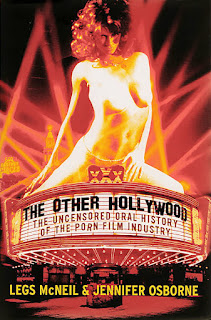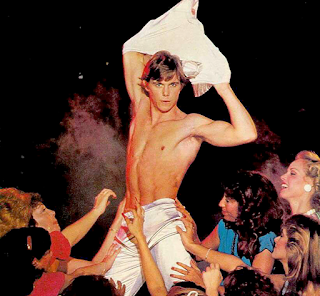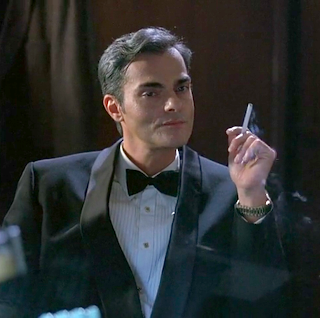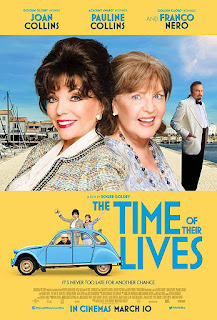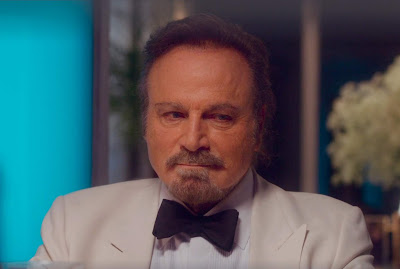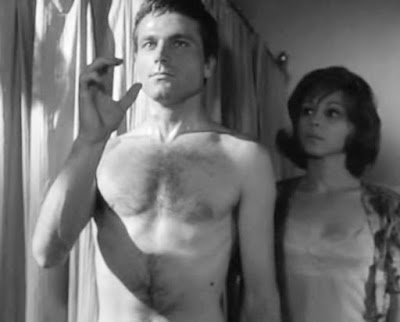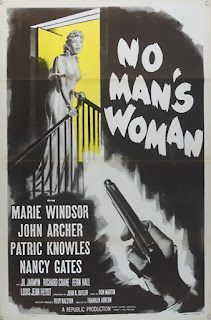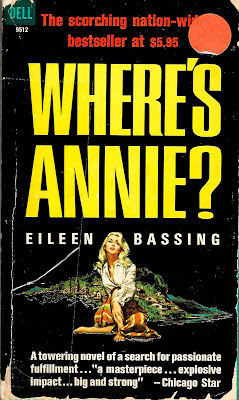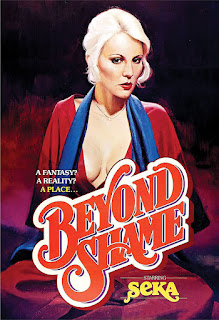 |
| I watched a crappy VHS rip online (#cheapassqueen), but Vinegar Syndrome has a pristine DVD available. |
A Place Beyond Shame likely wasn’t going to be a hardcore take on RM’s Mudhoney, of course, but by this point I was so enamored by the title that I felt compelled to watch it, even if its story was considerably less ambitious than I wanted it to be.
Said story is slight indeed. Seka (or “Seka,” as the star is cast as “herself”) has an acute lack of sex drive—you know, just like Seka. Sex repulses her, in fact. When her suitor in the opening scene, Paul (Don Fernando), makes advances, she tries to put him off. “I’ve got hors d’oeuvres warming in the oven,” she says, trying to escape his embrace. “You’re the tastiest hors d’oeuvres I see,” is Paul’s leering reply. (Three people are credited with writing the script.) Seka tolerates Paul’s roving hands, but she can’t hide her revulsion when he guides her hand to his dick—not that Paul notices. “I’m gonna fuck you,” he pants. Not tonight, he isn’t. Seka angrily pushes him away.
 |
| Who can fuck with a boom mic looming overhead? |
It turns out Diana had problem similar to Seka’s (“Not a heavy one. I just couldn’t come.”) and she knows a guy who can help. That guy is Michael, played by Paul Thomas. During Seka’s first meeting with him we learn that she’s a computer programmer (I feel cheated that we’re denied scenes of her at work, busily coding). “And you’re here to be reprogrammed,” Michael says. (Three screenwriters, ladies and gentlemen.) He tells Seka that he can help her complete her “book of thoughts.” Translation: he’s a hypnotist. Now if only someone can help Michael get rid of that boom dangling just above his head.
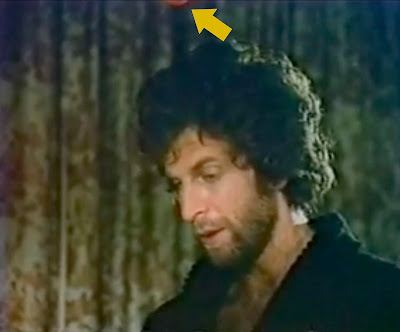 |
| Paul Thomas with special guest star: the boom mic. |
There is also an extended sequence during which a hypnotized Seka “sees” Jesse Adams as a cowboy getting it on with cowgirl Lysa Thatcher; Diana Holt getting her cooch crushed by Cossack cosplayer Aaron Stuart; and some obligatory girl-on-girl action between Mai Lin and China Leigh, who are later joined, all of a sudden, by Billy Dee. Intercut between these different sex scenes is footage of a Seka, uncontrollably turned-on, stripping off her clothes, turning her butt to the camera and digitally exploring her lower orifices.
TL;DR: A Rant About Scene Length, Unimaginative Filming
This montage of four different sex scenes makes up nearly a quarter of the movie’s 75-minute runtime, which is damn near epic compared to all the movie’s other sex scenes that usually clock in at four minutes. Yes, four minutes! That’s barely enough time to work up a hard-on. Lest you feel cheated, the brevity of the sex scenes is offset by the sheer number of them: a whopping nine, counting that 23-minute montage as one and not counting Seka and Fernando’s abortive attempt at the movie’s opening. Of course, 23 minutes seems stingy by current porn standards, when a single scene can be over 30 minutes long, with at least 20 spent on pounding ass (or pussy, though my experience with current straight porn is limited to my hasty perusal of what’s available on aebn.com). They’re not scenes anymore; they’re gifs. Personally, I find 10-15 minutes per hardcore sex scene a happy medium: long enough to perform a variety of sex acts, but short enough to keep the scene from becoming boring and repetitive. Speaking of boring and repetitive sex scenes, the aforementioned montage highlights directors Sharon Mitchell and the late Fred Lincoln’s lack of inventiveness in filming them, the pair favoring the alternation between close-ups of faces and close-ups of genitalia. At one point I lost track, as can happen when you check your phone, and couldn’t be sure if the out-of-context cock and pussy on my screen belonged to Adams and Thatcher or Holt and Stuart (Lin, Leigh and Dee were a bit more distinguishable). Sure, the draw of these movies is that they show non-simulated sex, but we want to appreciate the rest of the performers’ bodies, too. I certainly wanted more coverage of a few of the guys—namely Blair Harris, Jesse Adams and Aaron Stuart—but even the women are often little more than disembodied vaginas.
And Now, Back to Our Feature Presentation
The therapist, Michael, having shown remarkable restraint while his patient masturbated a few feet away from where he sat, finally gives Seka the necessary hot meat injection to push her Beyond Shame (a surprisingly underwhelming scene). A cumshot later, Seka is all horned up and ready go out into the world and fuck, starting with a jogger (R.J. Reynolds) she and Diana pick up in the park. (When the jogger responds to Diana’s proposition with, “I’m game!”, I thought he said, “I’m gay!”, which I thought would’ve been a funny twist.*) Seka may be horny, but she’s still apprehensive, having to be coached by Diana when handling the jogger’s member: “Wanna try to suck it? C’mon, it won’t bite you.”The finale sees Seka having a do-over date with Paul, the newly confident “computer programmer” ordering the young man to get out of his clothes and promising to give him the ride of his life. Once said ride is completed, Seka turns to the camera and says, “Look out world, here I come”—and it’s obvious by her seductive tone how “come” should be spelled.
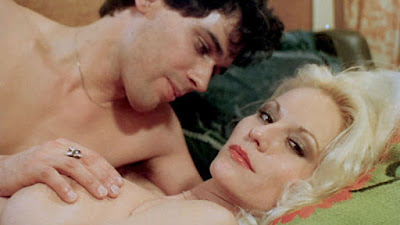 |
| Look out world! |
Sharon, Fred and Seka
In her interview with the Rialto Report, Seka says Dracula Sucks was her first feature (IMDb lists Love Notes as her first movie but that just may be the first of her movies to be released). In fact, there are a lot of contradictions in the recollections in The Other Hollywood and what Seka herself told the Rialto Report (she wasn’t interviewed by The Other Hollywood authors). Mitchell says she was the one who coached Seka on losing her “horrible Southern accent” and pornographer Roy Karch says it was the late porn star Bill Margold who came up with the name Seka. In her Rialto Report interview, Seka says she took voice and elocution lessons to lose her accent before she ever got into porn and that she got the name Seka from a woman she knew in Las Vegas. Was I to read Seka’s autobiography, Inside Seka, I’m sure I’d encounter even more contradictions, but my to-be-read pile is pretty daunting as it is. Considering that everyone involved is recounting events from decades ago and all have consumed more than their fair share of drugs during that time, it’s best to just take everyone’s account with a grain of salt (or, in the spirit of the Golden Age of Porn, a line of coke).
So, how about the final product? Lincoln and Mitchell did a respectable job (we’ll forgive those boom mic intrusions and sometimes murky lighting, though these aren't issues in the Vinegar Syndrome DVD release), but I didn’t enjoy it as a film as I did Every Inch a Lady. It’s just something to jerk-off to, the work of performers looking for a Plan B, not aspiring filmmakers looking for a creative outlet. (Lincoln directed nearly 350 porn videos before his death in 2013, so the move to directing clearly worked out for him.) The only thing that makes Shame distinctive is its leading lady. “I’ve never been an actor,” Seka told the Rialto Report, and she’s not—she’s a star, and she’s about the only reason to see Shame. I still love the title, though.
*R.J. Reynolds was bi, with a few gay porn titles— Jockstrap, Joe Gage’s Closed Set—in his filmography. He died in 1987 from an AIDS-related illness at the age of 32. Now I’ve made you sad.

